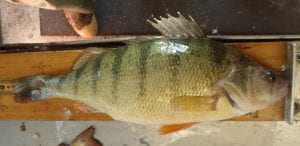My research explores mechanisms that regulate fish population and community structure, as well as food web interactions in both freshwater and marine systems. Typically, I have sought to apply my research to resource management problems such that agencies can make informed decisions about the environment. Overall, my research encompasses three broad and interconnected areas described below. Overlap in these research areas as well as in projects at the lab lead to synergy and teamwork; read more about that here.
I designed my research program so that I can understand the conditions that allow findings about ecological processes to be generalized across aquatic ecosystems. To accomplish this, I try to ask similar research questions and use similar integrative and interdisciplinary approaches in different ecosystems (e.g., hypoxia research in Lake Erie, Chesapeake Bay, the northern Gulf of Mexico, and Ohio reservoirs; ICPBM research with walleye and yellow perch) or with different species (e.g., recruitment research with largemouth bass, walleye, yellow perch, channel catfish, and masked gobies). In this way, my research aims to save time and money by adopting a strategy that allows findings from one system to be applied to another, thus increasing the ability of our research to have a broader impact on the sustainability of ecosystems across the globe.
Find more information on projects at the lab here and at the Aquatic Ecology Lab projects page.
Fish Recruitment & Early Life History
 Understanding the process of recruitment is essential to interpreting and predicting the demographics and dynamics of populations and, in turn, understanding the broader community as a whole. This component of my research has sought to identify the mechanisms that regulate the survival, growth and behavior of eggs, larvae, and juvenile fish in a variety of ecosystems. Understanding these regulatory mechanisms leads to a better understanding of when and how recruitment is set which helps to predict population demographics and patterns in community structure. Finally, all of this information contributes to the development of appropriate management and conservation strategies.
Understanding the process of recruitment is essential to interpreting and predicting the demographics and dynamics of populations and, in turn, understanding the broader community as a whole. This component of my research has sought to identify the mechanisms that regulate the survival, growth and behavior of eggs, larvae, and juvenile fish in a variety of ecosystems. Understanding these regulatory mechanisms leads to a better understanding of when and how recruitment is set which helps to predict population demographics and patterns in community structure. Finally, all of this information contributes to the development of appropriate management and conservation strategies.
Check out the Fish Recruitment & Early Life History page for more information as well as some of my publications and projects in this area.
Stock Discrimination & Population Connectivity
 Animal populations are often composed of subpopulations that are spatially separated at least some of the time. These subpopulations often have different levels of contribution to the broader population, with some contributing a great deal to the larger population and others contributing less. These differences can also shift with environmental variation (e.g. warm vs. cold winter, dry year vs. wet year). It is important to understand the ways in which subpopulations contribute to the broader population to inform management and conservation decisions.
Animal populations are often composed of subpopulations that are spatially separated at least some of the time. These subpopulations often have different levels of contribution to the broader population, with some contributing a great deal to the larger population and others contributing less. These differences can also shift with environmental variation (e.g. warm vs. cold winter, dry year vs. wet year). It is important to understand the ways in which subpopulations contribute to the broader population to inform management and conservation decisions.
Check out the Stock Discrimination & Population Connectivity page for more information as well as some of my publications and projects in this area.
Global Change Ecology
 Past and current major research projects have focused on integrative, multidisciplinary research approaches to learn how human-driven nutrient pollution, land-use change, invasive species, and climate change act to structure our ecosystems, as well as how to protect valued ecosystems and their services (e.g., fisheries production, clean water) from the potential impacts of these stressors.
Past and current major research projects have focused on integrative, multidisciplinary research approaches to learn how human-driven nutrient pollution, land-use change, invasive species, and climate change act to structure our ecosystems, as well as how to protect valued ecosystems and their services (e.g., fisheries production, clean water) from the potential impacts of these stressors.
Check out the Global Change Ecology page for more information as well as some of my publications and projects in this area.